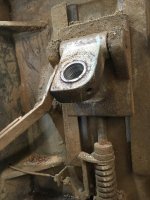LandscapePenguin
Plastic
- Joined
- Jun 13, 2019
I'm trying to clean up an old 1612-3 saw and want to remove the top wheel. Does anyone know how it comes off? I can rotate the top on top only a couple of turns then it becomes extremely tight. A wrench can turn it a little further but it still tightens up and I don't want to break anything forcing it.
There were two knobs on the shaft. The outside knob was a pressure fit to the shaft with a spring pin driven into the face at the joint where the wheel met the shaft. I've removed the pin and outside wheel. The inside wheel appears to be locked to the shaft but that's the one that I can't figure out how to get off.
There were two knobs on the shaft. The outside knob was a pressure fit to the shaft with a spring pin driven into the face at the joint where the wheel met the shaft. I've removed the pin and outside wheel. The inside wheel appears to be locked to the shaft but that's the one that I can't figure out how to get off.



